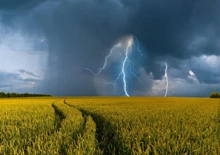
With the growing population, the food requirement of the world is also increasing rapidly. And wheat is an important food crop that plays a crucial role in meeting the world food requirement. Wheat can be grown all over the world but when it comes to production, China tops the list, followed by India and the US.
The scientific Name of wheat is Triticum aestivum and it belongs to the family Poaceae and the genus Triticum L. Wheat is a healthy as well as wholesome food and many people grow only a limited stock of it to meet their daily food requirements.
Wheat indeed is the best cereal grain as it contains higher protein than maize and rice. Moreover, it is believed to be the best staple food in today’s world. It is also used in preparing various food items like bread, biscuit, cereal, cookies, cakes, pasta, noodles etc.
Wheat Cultivation
Wheat farming or cultivation can be very easily done as compared to many other cereal crops. Here is how you can start with it:
1. Choose a good location
The very important part of wheat farming is a selection of an appropriate place. You must look for a place that has fertile soil for wheat farming. Soil with a loam texture, good structure and moderate water holding capacity are some factors that you must consider to grow wheat.
2. Soil Preparation
The soil must be properly prepared before starting wheat farming. For this, you can plough the soil either with a disc or mouldboard plough. Then arrange the soil by giving one deep plough, followed by 2 to 3 light ploughing and planking. Now add natural fertilizers to it. For commercial wheat farming, an average of 50 kg Nitrogen, 25 kg Phosphorus and 12 kg Potash is sufficient in one acre of land. Add more organic contents while preparing the soil.
3. Weather requirements
Wheat plants can be grown and planted in a wide range of agro-climatic conditions. The plants have high flexibility and hence can be grown in the tropical, sub-tropical zones and temperate zone. The most suitable climate for wheat farming is moist and cool weather. The plants can easily survive in temperatures between 3.5 °C and 35 °C, but the best temperature for wheat farming is between 21 °C and 26 °C.
4. Pick a variety
Wheat is available in many different types and varieties all over the world. Some popular wheat varieties available and cultivated in India are as follows:
-
DBW 17,
-
HD 2851,
-
HD 2932,
-
PBW 1 Zn,
-
Unnat PBW 343,
-
PDW 233,
-
WHD 943,
-
TL 2908, etc
Make sure you choose the right variety of wheat according to the climatic conditions of your region. You can also consult an experienced farmer in your area to help you choose the right wheat variety.
Seeding
Wheat seeds are easily available in the market. While purchasing the seeds, make sure it is of good quality, high yielding and disease-free. Usually, 40 to 50 kg seeds are required in one acre of land. Although the exact amount of seeds required depends on the variety and sowing method.

Planting
The wheat seeds must be sown about 4 to 5 cm inside the soil. Always put the seeds in rows and maintain a spacing of 20-22.5 cm between the rows. Planting or sowing the seeds at the right time is also important as delayed sowing can cause a gradual decline in production. In India, it is generally sown at the end of October and early November.
Also, see that the wheat seeds are properly graded and thoroughly cleaned before sowing. Here you can apply a fungicide for treating the seeds.
Caring
The wheat plants are quite tough and strong. They generally do well in favorable climate conditions and require less care. And if you take some extra care, it will be good and will ensure maximum production.
-
Fertilization – you don’t need to add more fertilizers if you had previously added it while preparing the soil.
-
Watering – good and proper irrigation is required for wheat farming. First irrigation must be done after 20 to 25 days after planting the seeds. Then, an additional 4 to 5 irrigation should be done after every 20 days.
-
Weeding: Most of the weeds in your field can be controlled while preparing the soil. Hence make sure you remove the weeds properly. For an additional wedding, you can use a wide range of chemicals available on the market.
Pest and disease control
The wheat plants are susceptible to many pests and diseases like aphids and termites. While some of the common diseases in wheat plants are brown rust, powdery mildew, Flag smut, etc. To control the pests or diseases, you can use good quality pesticides or insecticides. You can also consult with the local agriculture extension office or an expert who can give you proper advice on it.
Harvesting
Harvesting starts when the leaves and stem turn yellow in color and become fairly dry. Remember that the wheat must be harvested before it is dead ripe to avoid loss in yield. Thus, timely harvesting is necessary for good quality as well as maximum production of wheat. When the moisture content in the wheat reaches about 25 - 30%, then the wheat is ready to be harvested. Combine harvesters are available in the market for harvesting, threshing, and winnowing of wheat crop in a single operation.









